Make: Electronics (6 page)
Authors: Charles Platt

But volts are only half of the story. When electrons flow through a wire, the flow is known as
amperage
, named after yet another electrical pioneer, André-Marie Ampère. The flow is also generally known as current. It’s the current—the amperage—that generates the heat.
Background
Why didn’t your tongue get hot?
When you touched the 9-volt battery to your tongue, you felt a tingle, but no perceptible heat. When you shorted out a battery, you generated a noticeable amount of heat, even though you used a lower voltage. How can we explain this?
The electrical resistance of your tongue is very high, which reduces the flow of electrons. The resistance of a wire is very low, so if there’s only a wire connecting the two terminals of the battery, more current will pass through it, creating more heat. If all other factors remain constant:
- Lower resistance allows more current to flow (Figure 1-34).
- The heat generated by electricity is proportional to the amount of electricity (the current) that flows.
Here are some other basic concepts:
- The flow of electricity per second is measured in amperes, or amps.
- The pressure of electricity, measured in volts, causes the flow.
- The resistance to the flow is measured in ohms.
- A higher resistance restricts the current.
- A higher voltage overcomes resistance and increases the current.

Figure 1-34.
Larger resistance results in smaller flow—but if you increase the pressure, it may overcome the resistance and increase the flow.
If you’re wondering exactly how much current flows between the terminals of a battery when you short it out, that’s a difficult question to answer. If you try to use your multimeter to measure it, you’re liable to blow the fuse inside the meter. Still, you can use your very own 3-amp fuse, which we can sacrifice because it didn’t cost very much.
First inspect the fuse very carefully, using a magnifying glass if you have one. You should see a tiny S-shape in the transparent window at the center of the fuse. That S is a thin section of metal that melts easily.
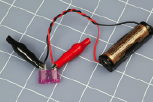
Figure 1-35.
When you attach both wires to the fuse, the little S-shaped element inside will melt almost instantly.
Remove the battery that you short-circuited. It is no longer useful for anything, and should be recycled if possible. Put a fresh battery into the battery carrier, connect the fuse as shown in Figure 1-35, and take another look. You should see a break in the center of the S shape, where the metal melted almost instantly. Figure 1-36 shows the fuse before you connected it, and Figure 1-37 depicts a blown fuse. This is how a fuse works: it melts to protect the rest of the circuit. That tiny break inside the fuse stops any more current from flowing.
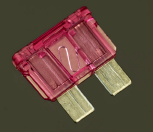
Figure 1-36.
A 3-amp fuse, before its element was melted by a single 1.5-volt battery.
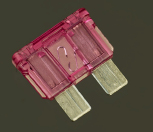
Figure 1-37.
The same fuse after being melted by electric current.
Fundamentals
Volt basics
Electrical pressure is measured in volts. The volt is an international unit. A millivolt is 1/1,000 of a volt.
Number of volts | Usually expressed as | Abbreviated as |
0.001 volts | 1 millivolt | 1 mV |
0.01 volts | 10 millivolts | 10 mV |
0.1 volts | 100 millivolts | 100 mV |
1 volt | 1,000 millivolts | 1V |
Ampere basics
We measure electrical flow in amperes, or amps. The ampere is an international unit, often referred to as an “amp.” A milliamp is 1/1,000 of an ampere.
Number of amperes | Usually expressed as | Abbreviated as |
0.001 amps | 1 milliamp | 1 mA |
0.01 amps | 10 milliamps | 10 mA |
0.1 amps | 100 milliamps | 100 mA |
1 amp | 1,000 milliamps | 1A |
Background
Inventor of the battery
Alessandro Volta (Figure 1-38) was born in Italy in 1745, long before science was broken up into specialties. After studying chemistry (he discovered methane in 1776), he became a professor of physics and became interested in the so-called galvanic response, whereby a frog’s leg will twitch in response to a jolt of static electricity.
Using a wine glass full of salt water, Volta demonstrated that the chemical reaction between two electrodes, one made of copper, the other of zinc, will generate a steady electric current. In 1800, he refined his apparatus by stacking plates of copper and zinc, separated by cardboard soaked in salt and water. This “voltaic pile” was the first electric battery.
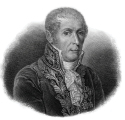
Figure 1-38.
Alessandro Volta discovered that chemical reactions can create electricity.
Fundamentals
Direct and alternating current
The flow of current that you get from a battery is known as
direct current
, or DC. Like the flow of water from a faucet, it is a steady stream, in one direction.
The flow of current that you get from the “hot” wire in a power outlet in your home is very different. It changes from positive to negative 60 times each second (in Great Britain and some other nations, 50 times per second). This is known as
alternating current
, or AC, which is more like the pulsatile flow you get from a power washer.
Alternating current is essential for some purposes, such as cranking up voltage so that electricity can be distributed over long distances. AC is also useful in motors and domestic appliances. The parts of an American power outlet are shown in Figure 1-39. A few other nations, such as Japan, also use American-style outlets.
For most of this book I’m going to be talking about DC, for two reasons: first, most simple electronic circuits are powered with DC, and second, the way it behaves is much easier to understand.
I won’t bother to mention repeatedly that I’m dealing with DC. Just assume that everything is DC unless otherwise noted.
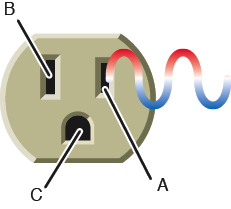
Figure 1-39.
This style of power outlet is found in North America, South America, Japan, and some other nations. European outlets look different, but the principle remains the same. Socket A is the “live” side of the outlet, supplying voltage that alternates between positive and negative, relative to socket B, which is called the “neutral” side. If an appliance develops a fault such as an internal loose wire, it should protect you by sinking the voltage through socket C, the ground.
Background
Father of electromagnetism
Born in 1775 in France, André-Marie Ampère (Figure 1-40) was a mathematical prodigy who became a science teacher, despite being largely self-educated in his father’s library. His best-known work was to derive a theory of electromagnetism in 1820, describing the way that an electric current generates a magnetic field. He also built the first instrument to measure the flow of electricity (now known as a
galvanometer
), and discovered the element fluorine.
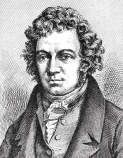
Figure 1-40.
Andre-Marie Ampere found that an electric current running through a wire creates a magnetic field around it. He used this principle to make the first reliable measurements of what came to be known as amperage.
